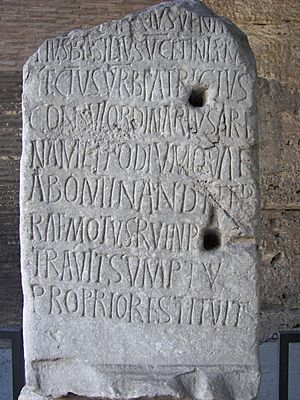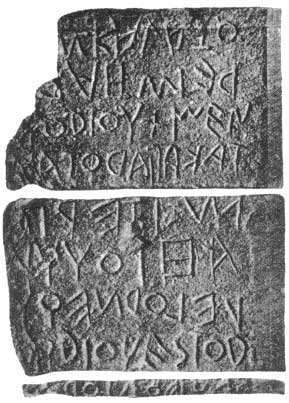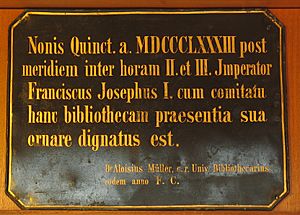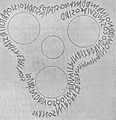Latin facts for kids
Quick facts for kids Latin |
|
|---|---|
| Lingua latina | |

Latin inscription in the Colosseum
|
|
| Native to | Latium, Roman Monarchy, Roman Republic, Roman Empire, Medieval and Early modern Europe, Armenian Kingdom of Cilicia (as lingua franca), Vatican City |
| Ethnicity | Latins |
| Era | Vulgar Latin developed into Romance languages, 6th to 9th centuries. latin was lingua franca of medieval Western Europe, and the liturgical language of the Roman Catholic Church. |
| Language family | |
| Writing system | Latin alphabet |
| Official status | |
| Official language in | |
| Regulated by | In ancient times, Roman schools of grammar and rhetoric. Today, the Pontifical Academy for Latin. |
| Linguasphere | 51-AAB-a |
Latin is a very old language that was spoken in Ancient Rome. The first short Latin texts were written around 500 BC. Longer texts appeared about 200 years later.
Classical Latin was the official language of the Roman Empire in the 1st century BC. It was used widely in the western part of the Mediterranean. The languages we call Romance languages grew from a spoken version of Latin, known as vulgar Latin.
Even though no one speaks Latin as their first language anymore, many people still study it. It helps us understand how society worked in the past. It also teaches us how languages are built. Knowing Latin makes it easier to learn Romance languages like Spanish or French.
Today, Latin is still used in taxonomy. This is how scientists give official names to species of living things. Many terms in medicine for body parts (like bones) and diseases also come from Latin.
Latin was very important for Christianity for many centuries. It is still used today in some religious events. It is an official language in the Vatican. This is where the Pope leads the Roman Catholic Church. People in the Vatican sometimes speak Latin to each other if they have different mother tongues. The Catholic Church's mass can even be held entirely in Latin.
Contents
Types of Latin
There were two main types of Latin: classical Latin and vulgar Latin. Classical Latin was used by educated Romans. It is the type used by the Roman Catholic Church and studied by students worldwide. Vulgar Latin was the everyday language spoken by most Romans. It was also taught to people in lands conquered by the Romans.
Latin was the most important language in much of Europe during the Middle Ages. It was taught in many European schools. All universities used Latin for teaching. Latin started to become less important during the Reformation. However, it was still often used by writers of scientific books and encyclopedias. Until about 1900, many universities accepted dissertations written in Latin.
As people in different parts of Europe learned vulgar Latin during Roman conquests, their own languages slowly grew from it. These new languages were simpler forms of Latin. They are called Romance languages, and they are still spoken today. The five Romance languages with the most speakers are Spanish, French, Portuguese, Italian, and Romanian. These languages are quite similar. People who speak one Romance language can often understand many words and sentences from another. For example, Portuguese speakers can often understand Spanish. You could say that Romance languages are like modern dialects of Latin.
How Latin Works: Grammar Basics
Latin has a grammar structure similar to Ancient Greek. However, it uses a different alphabet.
Latin nouns change their endings based on how they are used in a sentence. This is called declining a noun. Latin has seven different ways a noun can be used, called noun cases. These are: nominative, vocative, accusative, genitive, dative, ablative, and locative. The vocative case is usually the same as the nominative. The locative often looks like the dative.
Nouns are grouped into five different ways they can be declined. These are called declensions. Each declension has special endings that show which group a noun belongs to. When a noun is declined, it can have twelve different forms.
Verbs also change their endings. This is called conjugating a verb. When a verb is conjugated, it can have six different forms. Five things can change a verb: who is doing the action (person), how many are doing it (number), when it happens (tense), if the subject is doing or receiving the action (voice), and the purpose of the action (mood). In total, there are 120 possible forms for each Latin verb!
Writing Latin in Ancient Times
Latin used to be written on wax tablets. These tablets had little space, so words were often written without any spaces between them. Sometimes papyrus was used, but it was very expensive. Punctuation marks were an old idea, but they came to Latin much later. Lowercase letters (small letters) are a more recent invention. The Roman alphabet came from the Etruscan language.
Here is an English translation of an old Latin text by Ovid. It describes a time called the Golden Age:
"This was the Golden Age that, without anyone forcing it, without laws, naturally cared for what was good and true. There was no fear or punishment. No threatening words were written on bronze. No crowds of people were afraid of a judge. They lived safely without needing protection. No pine tree cut from the mountains had yet reached the water to travel to other lands. People only knew their own shores. There were no deep ditches around towns. There were no trumpets or horns for war. There were no helmets or swords. Without armies, people lived their lives in gentle peace and safety."
Latin After the Roman Empire
After the Roman Empire fell, many people still used Latin. Scholars like Thomas Aquinas, Petrarch, Erasmus, Luther, Copernicus, Descartes, and Newton wrote their important works in Latin. For example, Hugo Grotius published his book "De jure belli ac pacis" (which means "On the Law of War and Peace") in 1625. This book became one of the foundations of international law.
Images for kids
-
The Latin Malmesbury Bible from 1407
-
The signs at Wallsend Metro station are in English and Latin, as a tribute to Wallsend's role as one of the outposts of the Roman Empire, as the eastern end of Hadrian's Wall (hence the name) at Segedunum.
-
Julius Caesar's Commentarii de Bello Gallico is one of the most famous classical Latin texts of the Golden Age of Latin. The unvarnished, journalistic style of this patrician general has long been taught as a model of the urbane Latin officially spoken and written in the floruit of the Roman Republic.
-
Latin and Ancient Greek at Duke University in Durham, North Carolina, 2014.
-
The Duenos Inscription, from the 6th century BC, is one of the earliest known Old Latin texts. It was found on the Quirinal Hill in Rome.
-
A modern Latin text written in the Old Roman Cursive inspired by the Vindolanda tablets, the oldest surviving handwritten documents in Britain. The word Romani ('Romans') is at bottom left.
See also
 In Spanish: Latín para niños
In Spanish: Latín para niños











